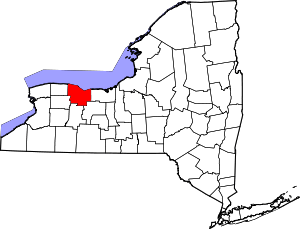Irondequoit, New York
Irondequoit /ɪˈrɒndəkɔɪt/ is a town (and census-designated place) in Monroe County, New York, United States. As of the 2010 census, the coterminous town-CDP had a total population of 51,692. Irondequoit is a major suburb of the city of Rochester, lying just north and east of the city limits. The name is of Iroquois origin and means "where the land meets the water".[3]
Irondequoit | |
|---|---|
Town | |
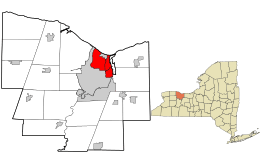 Location in Monroe County and the state of New York. | |
.svg.png) Location of New York in the United States | |
| Coordinates: 43°12′40″N 77°34′55″W | |
| Country | United States |
| State | New York |
| County | Monroe |
| Founded | 1839 |
| Government | |
| • Town Supervisor | David Seeley(D)
Town Council
|
| Area | |
| • Total | 16.82 sq mi (43.57 km2) |
| • Land | 14.99 sq mi (38.82 km2) |
| • Water | 1.83 sq mi (4.75 km2) |
| Elevation | 368 ft (112 m) |
| Population (2010) | |
| • Total | 51,692 |
| • Estimate (2019)[2] | 50,055 |
| • Density | 3,372.65/sq mi (1,302.15/km2) |
| Time zone | UTC-5 (EST) |
| • Summer (DST) | UTC-4 (EDT) |
| ZIP code | 14609, 14617, 14621, 14622 |
| Area code(s) | 585 |
| FIPS code | 36-055-37726 |
| Website | http://www.irondequoit.org/ |
History
In 1687 Marquis de Denonville led an army of French soldiers and Huron warriors on a punitive expedition against the Iroquois through Irondequoit Bay, beginning the long enmity between the Iroquois and the French.
After the American Revolution, this area was part of the Phelps and Gorham Purchase. The Town of Irondequoit was founded in 1839 when it separated from the Town of Brighton.
During the last part of the 19th century, the north edge of the town was developed as a tourist and vacation area for the City of Rochester residents, and was once known as the "Coney Island of Western New York."
After World War II, Irondequoit experienced significant population growth, with returning veterans looking for housing. Irondequoit became the first suburb in Monroe County to see substantial migration of residents from the City of Rochester, with the population growing from 23,376 in 1940 to 55,337 in 1960, a remarkable 136% increase. Irondequoit remained the most-populated suburb in Monroe County until the 1970s, when it was surpassed by the Town of Greece, a community with three-times the land mass of Irondequoit.
In 1965, Irondequoit became part of civil rights history by being part of the first totally voluntary desegregation program in U.S. history. The Urban Suburban Interdistrict Transfer Program, which still operates today, was begun with 25 first graders from the inner city of Rochester who embarked on their K-12 education in the West Irondequoit school district. Ultimately, 15 of the original 25 students graduated together in 1977 as part of the first graduating class ever to go through a full 12 years of voluntary desegregation. The achievement was acknowledged in a letter from the White House and a notation in the U.S. Congressional Record. The program has continued to expand and now includes additional suburban districts that are part of the Rochester metropolitan area.
Geography
According to the United States Census Bureau, the town has a total area of 16.8 sq mi (44 km2), of which 15.2 sq mi (39 km2) is land and 1.6 sq mi (4.1 km2) (9.69%) is water.
The town lies between the Genesee River on the west and Irondequoit Bay on the east. The north border of the town is defined by the shoreline of Lake Ontario. Because it is bounded by water on three sides, it is considered a geographical headland. Irondequoit is bordered by the city of Rochester to the west and south, the town of Brighton southeast, and the towns of Webster and Penfield to the east.
An unusual boundary exists between the Town of Irondequoit and the adjacent City of Rochester. On the western border of Irondequoit, the city claims a thin strip that extends northward along the banks of the river from Seneca Park to Lake Ontario, at some points less than 50 yards (46 m) from the shore. The result is that the City of Rochester claims the entire eastern shore of the Genesee, and the border of the Town of Irondequoit never reaches the river.
Similarly, the northern half of Durand-Eastman Park (including Durand Beach) lies within the city's borders, along with a narrow strip running along Culver Road for approximately 5 miles (8.0 km) southward to Norton Street. This leads to much confusion, even among long-term residents, about whether places such as Seneca Park or Durand Park lie within the Town of Irondequoit or the City of Rochester. Seneca Park was annexed by the City of Rochester in 1891, and Durand Eastman Park was given to the city in 1908.
Demographics
| Historical population | |||
|---|---|---|---|
| Census | Pop. | %± | |
| 1840 | 1,252 | — | |
| 1850 | 2,397 | 91.5% | |
| 1860 | 3,547 | 48.0% | |
| 1870 | 3,990 | 12.5% | |
| 1880 | 1,986 | −50.2% | |
| 1890 | 2,415 | 21.6% | |
| 1900 | 2,863 | 18.6% | |
| 1910 | 3,526 | 23.2% | |
| 1920 | 5,123 | 45.3% | |
| 1930 | 18,024 | 251.8% | |
| 1940 | 23,376 | 29.7% | |
| 1950 | 34,417 | 47.2% | |
| 1960 | 55,337 | 60.8% | |
| 1970 | 64,897 | 17.3% | |
| 1980 | 57,648 | −11.2% | |
| 1990 | 52,377 | −9.1% | |
| 2000 | 52,354 | 0.0% | |
| 2010 | 51,692 | −1.3% | |
| Est. 2019 | 50,055 | [2] | −3.2% |
| U.S. Decennial Census[4] | |||
As of the census[5] of 2000, there were 52,354 people, 22,247 households, and 14,327 families residing in the coterminous town-CDP. The population density was 3,447.4 per square mile (1,330.7/km²). There were 23,037 housing units at an average density of 1,516.9 per square mile (585.6/km²). The racial makeup of the town was 93.03% White, 3.55% Black or African American, 0.15% Native American, 0.98% Asian, 0.02% Pacific Islander, 1.02% from other races, and 1.25% from two or more races. Hispanic or Latino of any race were 3.06% of the population.
There were 22,247 households out of which 26.7% had children under the age of 18 living with them, 50.7% were married couples living together, 10.4% had a female householder with no husband present, and 35.6% were non-families. 30.8% of all households were made up of individuals and 16.7% had someone living alone who was 65 years of age or older. The average household size was 2.32 and the average family size was 2.91.
In the town, the population was spread out with 21.9% under the age of 18, 5.2% from 18 to 24, 26.6% from 25 to 44, 23.7% from 45 to 64, and 22.5% who were 65 years of age or older. The median age was 43 years. For every 100 females, there were 85.4 males. For every 100 females age 18 and over, there were 81.1 males.
The median income for a household in the town was $45,276, and the median income for a family was $55,493. Males had a median income of $41,463 versus $30,937 for females. The per capita income for the town was $23,638. About 3.8% of families and 5.4% of the population were below the poverty line, including 6.6% of those under age 18 and 6.8% of those age 65 or over.
Government
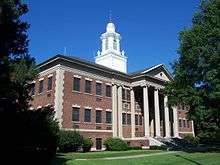
The town is governed by a town board consisting of a supervisor and four board members, all elected by registered town voters. The Supervisor, currently David Seeley, serves a two-year term. Board members represent the entire town and serve a four-year terms.
At present, the entire Town Board, including the Supervisor, is made up of members of the Democratic Party.
Irondequoit is known for its colonial-style Town Hall, built in 1951. It was completed with funds that had been previously set aside for two decades. It was listed on the historical registry in 2010 by the Irondequoit Historical Preservation Commission. On the Town Hall campus sits two relocated structures - a Pioneer House & a Cobblestone Blacksmith Shop - both of which are believed to be built in the 1830s.
Current Town Board
- John Perticone (Deputy Supervisor), 2008–present
- Nicole Hushla-Re, 2015–present
- Peter Wehner, 2016–present
- Kimie Romeo, 2018–present
| Name | Tenure | Name | Tenure | |
|---|---|---|---|---|
| William Shepherd | 1839 – 1840, 1842 | Joseph Aman | September 24, 1900 – 1905 | |
| William Blossom | 1841 | Chauncey W. Porter | 1906 – 1909, 1920 – 1925 | |
| Jonah Brown | 1843 – 1844 | Louis Dubelbeiss | 1910 – 1919 | |
| John McGonegal | 1845 – 1846 | William S. Titus | 1926 – 1927 | |
| James Mandeville | 1847 | Thomas E. Broderick | 1928 – October 1, 1949 | |
| James Swayne | 1848 – 1849, 1856 – 1857 | Frederick Hussey | October 2, 1949 – December 31, 1949, 1958 – 1959 | |
| Benjamin Wing | 1850 | Walter G. Lauterbach | 1950 – 1957 | |
| Samuel W. Bradstreet | 1851 – 1852 | Harold L. Knauf | 1960 – May 23, 1967, 1968 – 1969 | |
| John Smyles | 1853, 1858 – 1859 | Julian Underhill | May 24, 1967 – December 31, 1967, 1970 | |
| James Sherry | 1854 – 1855, 1863 | Donald A. Deming | 1972 – 1979 | |
| George McGonegal | 1860 – 1861 | Stephen R. Johnson | 1980 – 1983 | |
| Jedediah White | 1862 | Eugene C. Mazzola, Jr. | 1984 – 1989 | |
| Albert C. Hobbie | 1864 – 1866 | Frederick W. Lapple | 1990 – 1993 | |
| Richard D. Cole | 1867 – 1870 | Suzanne Masters | 1994–1995 | |
| Samuel Dubelbeiss | 1871 – 1872 | William S Dillon | 1996 – 1997 | |
| Henry Walzer | 1873 – 1876 | David W. Schantz | 1998–2005 | |
| Alexander H. Wilson | 1877 | Mary Ellen Heyman | 2006 – 2009 | |
| Winfield R. Wood | 1878 – 1879 | Mary Joyce D'Aurizio | 2010 – 2014 | |
| John Evershed | 1880 – 1882 | Adam Bello | 2014 - 2016 | |
| Richard Hill | 1883 – 1884 | David Seeley | 2016 – Present | |
| William H. Sours | 1885 – 1891 | |||
| John D. Whipple | 1892 – 1897 | |||
| Rudolph Dubelbeiss | 1898 – September 11, 1900 |
Notable people
The following notable people were either born in Irondequoit or were long-time residents:
- Richard Brookhiser[6] - noted historian and biographer of various American founding fathers, is a 1973 graduate of Irondequoit High School.
- Chuck Brucato - singer/songwriter for The Rustix. They were the first all white band signed to a Motown label in 1969, a few months prior to Rare Earth. Both recorded for the Rare Earth label. His son Joe Brucato, is also a popular musician and both live in Irondequoit.
- Cito Culver [7] - first round draft pick for the New York Yankees
- Steve Gadd, world-famous session drummer who has played with Paul Simon, Eric Clapton, Frank Sinatra, and others. His most famous work was his drum work on Fifty Ways to Leave Your Lover.
- Tom Golisano[8] - founder of Paychex and a three-time New York State gubernatorial candidate is a graduate of Irondequoit High School. He was also the owner of the Buffalo Sabres hockey team from 2003 to 2011.
- Don Holleder - All-American end on Army's 1954 football team, which led the nation in offense, grew up in Irondequoit. He died at age 33, killed in Vietnam by a sniper's bullet while attempting to rescue wounded comrades.
- Sean Lahman - journalist and author, is a graduate of Irondequoit High.
- Cal Ripken, Sr. - lived in the Sea Breeze neighborhood off Culver Road for several years in the late sixties and early seventies while he was managing the Rochester Red Wings baseball team. Two of his sons, Billy and Cal, Jr. went on to play in the major leagues.
- Kent Syverud - 12th Chancellor and President of Syracuse University and graduate of Irondequoit High School
- David Walker - college football star and current NFL assistant coach
- A number of students from Irondequoit High School have played professional sports at the major league level, including:
- Paul Cantabene - professional lacrosse player and college coach.
- Rory Fitzpatrick - defenseman with NHL's Montreal Canadiens, Buffalo Sabres, Vancouver Canucks
- Andy Hendel - NFL linebacker for the Miami Dolphins
- Quentin Gause - Professional Football Player, Bishop Kearney High School graduate & former Rutgers University standout linebacker
Communities and locations in Irondequoit
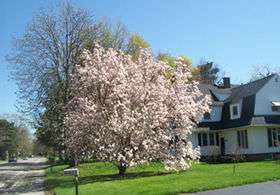
- Autumn View Estates – A neighborhood on a private road along Bayshore blvd.
- Bayview – A community on the west shore of Irondequoit bay in the southeast part of the town.
- Culver Meadows – A community immediately northwest of the interchange between the Keeler Expressway (NY 104) and the Sea Breeze Expressway (NY 590).
- Durand-Eastman Park – A large park geographically surrounded by the town on three sides and Lake Ontario on the other. The park is part of the City of Rochester and is connected to the city by an easement along Culver Road.
- Briarwood Triangle - Still home to some of Irondequoit's few remaining farmsteads, this neighborhood shares a name with the elementary school it surrounds, one of the best schools in the State.
- Eagle Heights - an area centered around Listwood Elementary School, Irondequoit High School & Dake Junior High School.
- German Village – The northeast section of Point Pleasant, along Irondequoit Bay.
- Glen Haven – A community on the west shore of Irondequoit bay in the southeast part of the town and south of Bayview.
- Heyer - Bayer Park – Named after longtime Irondequoit residents Arthur F. Heyer and George Bayer who donated the land to the town
- Huntington Hills - One of the oldest in neighborhoods in town that actually has an incorporated association. This secluded wooded area was once the summer home to many of Rochester's prominent citizens.
- Joshua Park – new park and soccer fields named for Joshua Rojas, an 11-year-old boy who died during soccer practice in 2005. It was formerly "Irondequoit Plaza Park."
- Laurelton - A neighborhood located in the southeast of Irondequoit featuring a portion of Irondequoit Bay; area was known for a variety of commercial farms pre-WWII. After WWII the area expanded greatly to accommodate young families looking for housing.
- Maywood - One of Irondequoit's older neighborhoods, many of the colonial revivals that marks the area were built during the Great Depression.
- McAvoy Park – A Park with playing fields and playground equipment.
- Nowadoga - Translated directly from the Seneca Language as "far and beautiful view" this is one of the oldest established neighborhoods in Irondequoit.
- Newport – A community south of Route 104 by Irondequoit Bay.
- Oakgrove - a largely wooded neighborhood adjacent to Durand Eastman Park and the Helmer Nature Center.
- Orchard Park – A neighborhood, situated in a former apple orchard, north of Empire Blvd., Route 404, and west of Irondequoit Bay.
- Pardee Hill - a neighborhood once home to the first peach orchard in Town, taking its name from one of the area's earliest settlers, Hiram Pardee
- Parkside – A location in the south western part of town that is densely populated and in close proximity to the river.
- Point Pleasant; a small community next to Irondequoit bay just south of Sea Breeze, with its own Pt. Pleasant fire department and elementary school. Used to have its own post office address. Identified by a small point of land sticking out into the bay and next to Schnackel Cove on the south side and German Village on the north side
- Seabreeze – A hamlet in the northern part of Irondequoit along Irondequoit Bay.
- Seneca Neighborhood: A neighborhood near and around Seneca Elementary School
- Seabreeze Amusement Park – Locally owned and run amusement park, one of the oldest in the nation.
- Summerville – A neighborhood along the lakefront of Lake Ontario, formerly summer cottages, now year-round homes. Summerville is in the northwest corner of the town.
- The Flats- A neighborhood formerly all farmland and horseradish fields now including the streets of Seneca Park Ave, St. Joseph Ave and surrounding streets
- White City – A shoreside neighborhood near Summerville.
- Windsor Beach – A shoreside neighborhood near Summerville.
- Winona Woods: A close-knit neighborhood on the town's west side, featuring a strong neighborhood association
Buildings, institutions, and other places of note
- Bishop Kearney High School – A co-educational Catholic High School.
- Camp Eastman –
- Reuben A. Dake Jr. High School
- Durand-Eastman Intermediate School – 95 Point Pleasant Road, Rochester, NY 14622
- Eastridge High School – Home of the Eastridge Lancers and the Iron Lancers – 2350 East Ridge Road, Rochester, NY 14622
- Helmer Nature Center – An outdoor learning facility visited by local school districts. Also open to general public with hiking trails and a pond with boardwalk
- House of Guitars – A famous local business noted for its strange commercials on TV. – 645 Titus Ave, Rochester, NY 14617
- Irondequoit Bay Outlet Bridge – The current seasonal bridge spans the bay outlet and connects Irondequoit and Webster. The bridge is in place for vehicular traffic during the winter. During the summer, usually beginning in late March, the bridge is removed to allow boats free passage between Irondequoit Bay and Lake Ontario. A 2017 feasibility study assessed a year-round alternative to bridge the outlet.
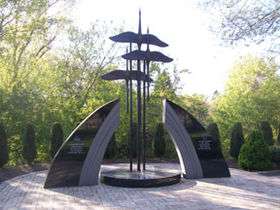
- Irondequoit Bay Bridge
- *Irondequoit Cemetery – A cemetery along the west side of Culver Rd.
- Irondequoit High School – Nickname changed from Indians to Eagles. – 260 Cooper Road, Rochester, NY 14617
- Irondequoit Public Library – Two branches (Helen McGraw and Pauline Evans) combined to one facility in 2015 – 1290 Titus Avenue, Rochester, NY 14617
- Skyview on the Ridge – formerly known as Medley Centre which was the Irondequoit Mall.
- Parkside Whispering Pines – the oldest miniature golf course still in existence. First opened in 1930. Listed on the National Register of Historic Places.[9]
- Point Pleasant Fire Department
- Sea Breeze Volunteer Fire Department
- St. Paul Blvd. Fire Department
- Ridge-Culver Fire Department
- Rochester Canoe Club – (Irondequoit, New York) Founded in 1881 for racing sailing-canoes on Irondequoit Bay, RCC has operated continuously since. Today, the club hosts three classes of racing sailboats and is home to an impressive group of nationally and world ranked racing sailors.
- The Reunion Inn – A local pub housed in a 19th-century building near Seabreeze Amusement Park. It is a popular place for good food.
- Seabreeze Amusement Park – The fourth-oldest amusement park in the country.
- St. Mary the Protectress, Ukrainian Autocephalous Orthodox Church
- The Flats – A valley by the Genesee River.
- St. Josaphat Ukrainian Catholic Church; established in 1909 as the first Ukrainian Catholic Parish in Monroe County. The Parish organizes and hosts the popular St. Josaphat Ukrainian Festival (established in 1972) held each year on the third weekend of August on the church grounds.
- United Congregational Church of Irondequoit, Listed on the National Register of Historic Places.[9]
Education
Irondequoit is served by the West Irondequoit and East Irondequoit central school districts.
Additionally, there are several schools with religious affiliations:
- Archangel School (Roman Catholic) operated by private individuals
- Bay Knoll School operated by the Seventh-day Adventists
- Derech Hatorah for Jewish education
- Bishop Kearney High School (independently owned) but affiliated with the Diocese of Rochester.
- Two schools operated by the Roman Catholic Diocese of Rochester:
- Christ The King Elementary School
- St. John Neumann School
Irondequoit is also the home of satellite campuses of two institutions of higher learning:
- Empire State College's Genesee Valley Learning Center
- Everest Institute's Rochester campus
High school athletics
- The Irondequoit Eagles basketball team captured its first ever New York State title with an impressive 54–43 win over Our Lady of Lourdes in Binghamton. 2017
- East vs. West Rivalry – IHS football beat the Eastridge football team several times in a row, but the 9 year streak came to an end when the Eastridge Lancers defeated IHS 48–10 in week 2 of the 2008 Section V football season. This is one of the most heated rivalries in Monroe County.
- Irondequoit High School Football – The football team has won back-to-back Section V Div. III titles in 2006 and 2007. More titles in 2010 & 2014.
- Irondequoit Lacrosse – The IHS lacrosse program has won 33 league titles and 16 Section V championships since 1957, most recently in '10 and '11 where they reached the New York State Semi-Finals. The program is the subject of a documentary, titled "Irondequoit: Lacrosse Town, USA", produced by Howie Nielsen.
- The Irondequoit girls volleyball program has won 2 Class A finals in a row. They were state champions in 2008.
- Eastridge Lancer boys volleyball won Sectional Championship.
- The Irondequoit Eagles Boys varsity soccer team reached its first Section V championship in 2009 and won in 2010.
- The Iron Lancers won the FIRST Robotics Competition Rookie All-star award at the RIT regional in 2010 and went on to compete in the finals in Atlanta, Georgia.
- The East Irondequoit Cheerleaders won a Grand National Championship in 2008 in Ocean City's Reach The Beach National tournament.
- The East Irondequoit Cheerleaders also won the county title in 2010. Also in 2010 the cheerleaders won another National Title in Disney's ESPN sports complex.
- The Eastridge Lancer Varsity football team has won three NYSPHSAA Section V Class A Championships, 2004, 2012 and 2013.
- West Irondequoit's boys soccer team was led by Matthew Hohler in 2010 to their first, and only, Section V title.
- Bishop Kearney boys basketball has won 14 Section V titles since 1994. They have also won state titles twice: Class B in 2009, and Class AA in 2013.[10]
- Bishop Kearney girls basketball have also won sectionals 5 times since 2012. Recently they have won the Class AA Title in 2015 and 2018. The team won the Class C state title in 2013.[10]
- BK boys soccer won the Class C2 Title in 2017. Girls volleyball has recently won sectionals twice: Class D1 in 2016, and Class D2 in 2018.[10]
- BK football won back-to-back in 2015 and 2016. The team won Class D in 2015; and won Class C in 2016.[10]
References
- "2016 U.S. Gazetteer Files". United States Census Bureau. Retrieved Jul 5, 2017.
- "Population and Housing Unit Estimates". Retrieved June 9, 2017.
- Richens, Thomas Cole; Wayne, Patricia (November 15, 2006). Irondequoit (NY) (Images of America). Arcadia Publishing. ISBN 0738549185.
- "Census of Population and Housing". Census.gov. Retrieved June 4, 2015.
- "U.S. Census website". United States Census Bureau. Retrieved 2008-01-31.
- Irondequoit High School grad earns prestigious award Archived 2012-02-15 at the Wayback Machine www.mpnnow.com. Retrieved 30 January 2009
- MLB.com 'Yanks stay close to home by tabbing Culver'
- Golisano Foundation.org Retrieved 30 January 2009
- "National Register Information System". National Register of Historic Places. National Park Service. July 9, 2010.
- "Section V Championships | Bishop Kearney School of Rochester NY | Roman Catholic Education". bkhs.org. Retrieved 2019-02-27.
External links
- Town of Irondequoit Official Website
- Irondequoit Public Library
- Town of Irondequoit.biz Business Portal
- Bishop Kearney High School
- Irondequoit Historical Society
- Dedication of Joshua Park
- Vintage Postcards with images of Irondequoit
- Article on plans for town center
- Newspaper series on history of Irondequoit
- Irondequoit Lighthouse Trail
- Medley Centre Website
- Transcript of WXXI news story and panel discussion on Urban Suburban Program (2003)
- Eastridge Robotics
- Laurelton Fire Department
- East Irondequoit Central School District
- West Irondequoit Central School District
- Ridge-Culver Fire Department
- Point Pleasant Fire Department
- Sea Breeze Fire Department
- Eastridge High School and Ninth Grade Academy
- Irondequoit High School
